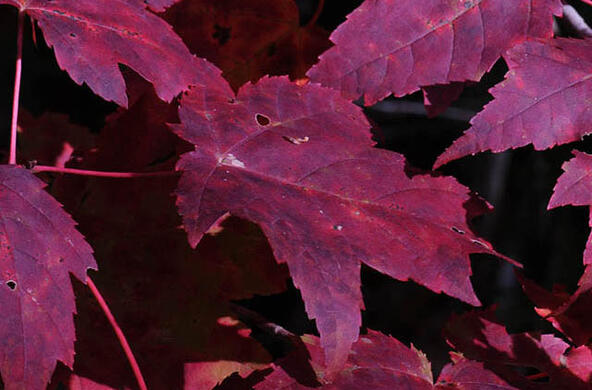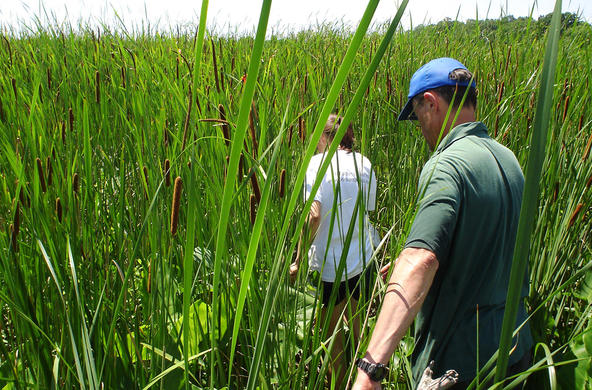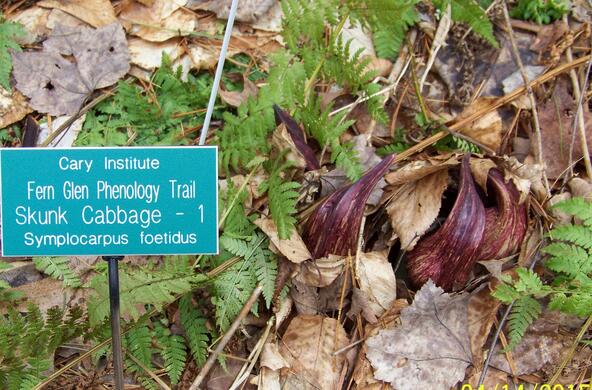Objectives
- Students will know what herbivory is and will be able to identify different forms of herbivory.
- Students will know how plants defend themselves and will be able to identify different forms of plant defense mechanisms.
Overview
Rating:
- Students will practice herbivory and think about what makes plants more or less susceptible to herbivory
- Students will evaluate damage from herbivory on different species of trees
- Students will draw conclusions about why different species have more or less herbivory
Materials
- Student Herbivory Worksheet
- CSI: Leaf Style Worksheet
- Individual white boards or poster paper
- Dry erase markers or markers
- Cameras (phone cameras), optional
- Herbivory ID Guide
- Clipboards
- Food samples for Student Herbivory Activity
- Suggested foods: Unripe bananas, cranberries, kiwi (unpeeled), kale, arugula, mint, rosemary, basil
Procedure
Preparation: Prior to the lesson, designate an area in your schoolyard for students to observe. It would be helpful to pre-survey the area for signs of herbivory and plant defenses so that guidance can be provided as necessary. Decide if you are going to allow students to collect any type of leaves with signs of herbivory or just maple vs. oak or another comparison, such as deciduous vs. coniferous. If you are allowing various leaf samples to be collected, be sure you have enough for the activity, and that students aren't near areas of poison ivy or other hazards when they are gathering leaves.
Engage:
Ask students to write the word “herbivore” on their white board and have them write down everything they know about herbivores. Push students to think beyond definitions and specific species. Challenge students to incorporate as much vocabulary as they can. As students are working, place leaves that have signs of herbivory on their desks. Ask them what they think caused the damage to the leaves and add their thoughts to their boards.
Have a “whip around,” calling on one student and have them share one response at a time. When called on, students should try not repeat a response; they must add something new. This formative assessment will help tell you whether students are thinking about who is doing the eating, why, or the consequences for the plant.
Introduce the term “herbivory” by writing it on the board and ask students what they think it means. You can also introduce the term “carnivory.” The leaf that you passed out is a good example of herbivory and students should have some guesses as to what kind of herbivore caused the damage. Ask them what an example of carnivory would look like?
Explore:
Day 1: Pass out the Student Herbivory Activity Worksheet. Students will participate in the act of herbivory, make observations about different plants, record findings, and then think about what characteristics plants have that would make them more or less susceptible to herbivory.
Plant compounds | Example foods |
High in tannins | Green bananas, cranberry juice |
High in lignins | Cereals, vegetable filaments, stones of fruits |
Toughness | Kale vs regular lettuce, rosemary |
High sulfur compounds (glucosinolates) | Arugula |
Defense mechanisms |
|
Hairs on skin | Kiwi |
Hard shell | Coconut |
Watch video: Cambridge Ideas - Don't Eat the Plants
https://www.youtube.com/watch?v=EFRCe65NV44
Project an image of poison ivy. Ask students if they know what it is? This kind of plant has a very successful defense against (many) humans. It produces urushiol, an oily compound that causes a reaction when touched.
Day 2: At the beginning of class, pass out the CSI Leaf Style Student Worksheet, hand out needed materials and assign student groups. Go over expectations of safety and behavior. Return to the Woodland Study plots and have each student select two tree species from which to collect five leaves. Leaves can be collected from the ground, or you can use a pole cutter to get leaves from lower branches. If not enough trees have low branches/leaves available for the students to gather, expand the hunt to include herbaceous plants. As students are collecting samples, ask them to look for signs of herbivory, and discuss the basic structure of the forest. Why does the forest looks like it does? Old trees vs. young? Size of trees? What determines what undergrowth is present? What determines what herbivores are present in the forest ecosystem (even if you can’t see them)? How does the edge of the forest compare to the forest interior? Other than food, what do the trees offer organisms?
Day 3: Back in the classroom, students should lay out their samples on trays and compare what they have found. They can use their herbivory guides to categorize the type of herbivory, and then analyze the amount and type of damage to leaves of both tree species. A simple way to do this is to place transparency grids over the leaves, and give the students a wet or dry erase marker to outline the leaf, and then mark which squares have damage, and which squares do not. The size of the grid can be adjusted to make this activity easier or harder (and more or less accurate!).
Explain:
Students should share their individual results and then make some conclusions using the class data about the types and amount of herbivory in their woodland plots. Have students read the Herbivory Student Reading to help them think about herbivory and answer the final question on the worksheet.
You can also watch these great videos on plant defenses:
NATURE | Plant Self-Defense | What Plants Talk About | PBS
https://www.youtube.com/watch?v=kYIWZuFsb60
Hearing danger: predator vibrations trigger plant chemical defenses
https://www.youtube.com/watch?v=TKQ-CIX9afA
Plants 'listen' for Danger Science News article https://www.sciencenewsforstudents.org/article/plants-listen-danger
Extend:
Invasive Insects: Many invasive insects are severe threats to our ecosystems because our producers have no defenses against them and the invading insects have no predators. These invasive insects can severely impact the biodiversity and health of our ecosystems.
http://www.caryinstitute.org/newsroom/emerald-ash-borer-and-other-invaders
http://www.caryinstitute.org/newsroom/new-york-hotbed-damaging-forest-pests
Evaluate:
Exit Activity: Choose one of the following statements and write a short paragraph about it. Use specific examples that you have learned during this lesson to support the statement.
I. Plants could actually be considered the dominant organisms in an ecosystem.
II. Not all plants are vulnerable, fragile, and defenseless against herbivores.
Resources
Lesson Files
vnd.openxmlformats-officedocument.presentationml.presentation
Herbivory ID
vnd.openxmlformats-officedocument.wordprocessingml.document
Student Worksheet
vnd.openxmlformats-officedocument.wordprocessingml.document
Student Reading







































































